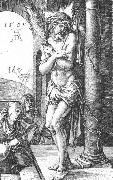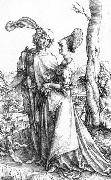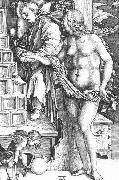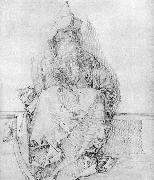
|
Artists
Index
|
||
|
Albrecht Durer
|
||
|
Christ on the Mount of Olives new21/Albrecht Durer-558526.jpg ID de tableau:: 63574 |
1521 Pen and ink, 208 x 294 mm St?delsches Kunstinstitut, Frankfurt Christ is lying completely flat on the ground ("fell on his face, and prayed",', ', ', ', ', ', ', '); D?rer could have seen this posture depicted by Mantegna. The rocks in starlike layers and the veil of mist pressing down from above lend support to the effect of the motif. The Apostles are small and are sitting off to a side by themselves.Artist:D?RER, Albrecht Title: Christ on the Mount of Olives Painted in 1501-1550 , German - - graphics : religious | |
| |
|
|
|
|
||
|
Man of Sorrows by the Column new21/Albrecht Durer-764753.jpg ID de tableau:: 63575 |
1509 Engraving, 116 x 75 mm Metropolitan Museum of Art, New York Sheet No. 1 of the Engraved Passion. Generally considered the frontispiece of the Engraved Passion. This print opens the Passion series, although it is not historical but a representation outside the Gospels. As such, it probably derives from Passion plays. In this version Christ is shown standing. Later, D?rer found the sitting position preferable and used it for the frontispieces of his woodcut Passions. The combination of the Man of Sorrows with the Virgin and St John was already used by Schongauer. The iconography is based on a vision experienced by St Bridget. The arrangement of the bystanders in half-length is quite new and remarkable. After this work D?rer suspended his engraving activity until 1511 and suddenly returned to producing a series of woodcuts after a lapse of more than five years. He issued more than thirty of the thirty-seven subjects of the Small Woodcut Passion during this period. The complete series was published in 1511. At the same time D?rer finally completed the Heller Altarpiece. In 1510 D?rer also prepared the additional sheets of the Large Woodcut Passion and the [woodcut] Life of the Virgin.Artist:D?RER, Albrecht Title: Man of Sorrows by the Column (No. 1) Painted in 1501-1550 , German - - graphics : religious | |
| |
|
|
|
|
||
|
Young Couple Threatened by Death new21/Albrecht Durer-853567.jpg ID de tableau:: 63576 |
1498 Engraving, 196 x 121 mm Staatliche Kunsthalle, Karlsruhe The Engraving showing a strolling couple is one of the genre pictures which D?rer created in the tradition of the Master of the Housebook and Martin Schongauer. As the gallant gazes at his companion adoringly, he points ahead to the path. The ostrich feather he is wearing in his hat is a sign of his bachelor status. The fantastic costume worn by the woman combines elements from both Nuremberg and Venetian fashion. Behind the tree, unnoticed by the lovers, Death is holding up an hourglass. The picture can be interpreted as a moralizing metaphor for the transitoriness of love and sensuality. The figure of death does not necessarily indicate a warning to lovers, as this was not customary in the fifteenth century. Death was, however, frequently pictured as a reminder that life on earth should not be solely devoted to pleasure and luxury. The cap worn by the man is a precursor of the berets which became popular in the sixteenth century. He has also already discarded the pointed shoes of the type still worn by his companion. The tall grass-like plant in the foreground may be allegorical, related to the quotation from Isaiah in the Basle Dance of Death that "all flesh is like hay and grass; grass dries up and flowers wilt. "Artist:D?RER, Albrecht Title: Young Couple Threatened by Death; or, the Promenade Painted in 1501-1550 , German - - graphics : mythological | |
| |
|
|
|
|
||
|
The Temptation of the Idler; or The Dream of the Doctor new21/Albrecht Durer-444536.jpg ID de tableau:: 63577 |
1498 Engraving, 188 x 119 mm Metropolitan Museum of Art, New York It has been observed by every commentator on D?rer's genius that in his work is found the blending .of two great traditions the medieval, culminating in the Gothic, and the revered Classical, rediscovered and nurtured by the Renaissance, especially in Italy. Erwin Panofsky feels that The Dream, sometimes called The Dream of the Doctor, should be titled The Temptation of the Idler, for here is pictured a slothful, self indulgent individual who sleeps in front of his heated fireplace, comfortably resting his head against a soft pillow. According to medieval codes of conduct such behaviour encouraged temptation, which is represented by the Devil, a demon who "blows" thoughts, presumably evil, into the sleeper's ear. Probably the dream itself is represented by the nude Venus, voluptuous and inviting. She is accompanied, no doubt to identify her, by a playful Eros. The model for the female form may well have been taken from the languorous women of the Italian Jacopo de' Barbari, whose engravings D?rer admired, or from other works by Italian masters which he knew. Young D?rer was trained as an apprentice in his father's goldsmith shop. There he learned the use of the graver or burin for incising designs and images into metal. Practically all of the great masters of the engraved print had similar early training. D?rer's mastery of his tools is evident in this print. Note the clean, sure flicks of the graver, suggesting modeling and volume. In the upper background, minute crosshatching is employed to project the sleeping figure forward from the rear plane. D?rer's training as a goldsmith also prepared him to render the hardware of the furniture, the texture of the tiles, and the graining of wood.Artist:D?RER, Albrecht Title: The Temptation of the Idler; or The Dream of the Doctor Painted in 1501-1550 , German - - graphics : other | |
| |
|
|
|
|
||
|
Seated Prophet new21/Albrecht Durer-696389.jpg ID de tableau:: 63578 |
1517 Pen, 232 x 192 mm Graphische Sammlung Albertina, Vienna Seen from below, his hands hidden in his lap, the prophet is a significant conception in the solemn and splendid style of the late 1510s.Artist:D?RER, Albrecht Title: Seated Prophet Painted in 1501-1550 , German - - graphics : study | |
| |
|
|
|
|
||
| Artiste précédent Artiste prochain | ||
|
Also Buy::. For Following Paintings / Artists / Products, Please Use Our Search Online: |










